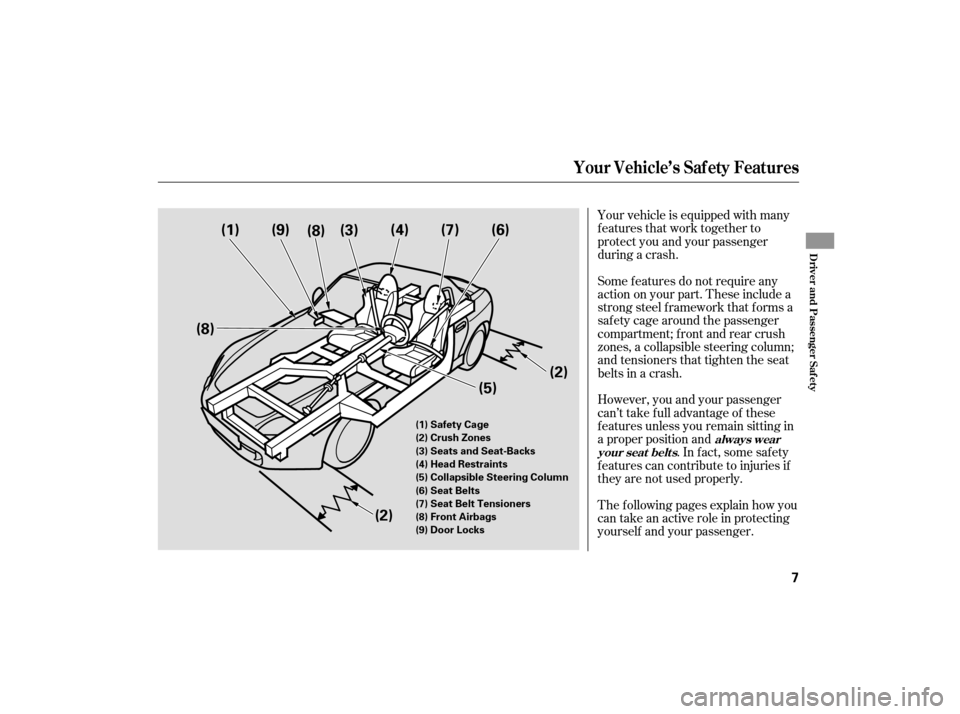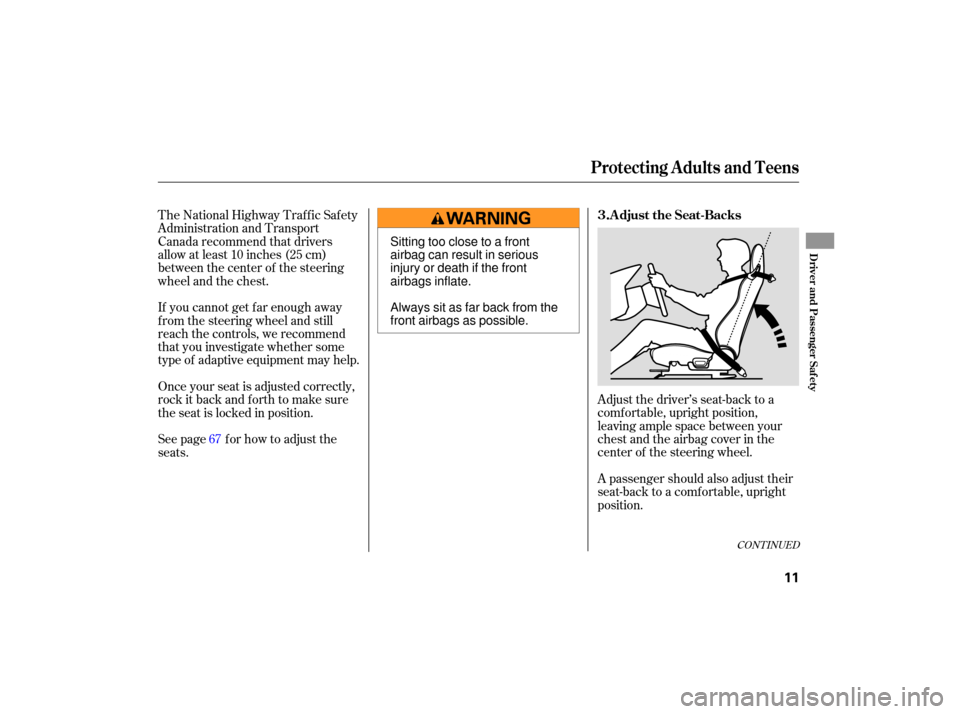Page 6 of 228
Your Vehicle at a Glance
You r Vehicle at a Glance
3
POWER WINDOW
SWITCHES
MIRROR
CONTROLS
ROOF SWITCH AUDIO SYSTEM
INSTRUMENT PANEL INDICATORS
GAUGES PASSENGER AIRBAG OFF INDICATOR
MANUAL
TRANSMISSION
REAR WINDOW DEFOGGER BUTTON HAZARD WARNING
BUTTON
(P.46)
(P.51)
(P.63) (P.68)
(P.75) (P.71) (P.59) (P.58)
POWER
DOOR
LOCK (P.26)
DRIVER’S FRONT
AIRBAG PASSENGER’S
FRONT
AIRBAG
(P.9, 20) (P.9,
20)
(P.88)
(P.125)
Page 7 of 228
Your Vehicle at a Glance
4
HOOD RELEASE HANDLE
HORNWINDSHIELD
WIPERS/
WASHERS
INSTRUMENT
PANEL BRIGHTNESS
(P.57)
(P.56)
(P.58)
VEHICLE
STABILITY ASSIST
(VSA) SYSTEM OFF SWITCH
CRUISE BUTTON
HEADLIGHTS/TURN
SIGNALS
REMOTE AUDIO
CONTROLS
CRUISE CONTROL
BUTTONS
HEATING/COOLING
CONTROLS
ENGINE START BUTTON
(P.104)
(P.124)
(P.112) (P.106) (P.106)
(P.84)
(P.131)
CLOCK
BUTTON
(P.54)
Page 8 of 228

�µ
This section gives you important
inf ormation about how to protect
yourself and your passenger. It
shows you how to use seat belts. It
explains how your airbags work. And
it tells you how to properly restrain
children in your vehicle. .........
Important Safety Precautions . 6
.......
Your Vehicle’s Saf ety Features . 7
.......................................
Seat Belts .8
...........................................
Airbags .9
.........
Protecting Adults and Teens . 10
.....
1. Close and Lock the Doors . 10
......................
2. Adjust the Seats .10
............
3. Adjust the Seat-Backs . 11
4. Fasten and Position the .............................
Seat Belts .12
5. Maintain a Proper Sitting ................................
Position .13
.....
Advice f or Pregnant Women . 14
...
Additional Safety Precautions . 15
Additional Inf ormation About .......................
Your Seat Belts .16
..
Seat Belt System Components . 16
......................
Lap/Shoulder Belt .17
Automatic Seat Belt ...............................
Tensioners .18
...............
Seat Belt Maintenance . 18
Additional Inf ormation About Your .....................................
Airbags .20
......
Airbag System Components . 20
...........
How Your Airbags Work . 22
..
How the SRS Indicator Works . 25How the Passenger Airbag Of f
......................
Indicator Works .26
.............................
Airbag Service .27
...
Additional Safety Precautions . 28
Protecting Children General ................................
Guidelines .29
All Children Must Be ...............................
Restrained .29
Your Vehicle is Not Recommended f or Child ..........................
Passengers .30
The Passenger’s Airbag .........
Can Pose Serious Risks . 30
...
Additional Safety Precautions . 32
.............
Protecting Small Children . 33
.....................
Selecting a Child Seat .34
....................
Installing a Child Seat .34
...........
Protecting Larger Children . 37
...............
Checking Seat Belt Fit . 37
..................
Using a Booster Seat . 38
When Can a Larger Child Ride ........................
in This Vehicle .39
...
Additional Safety Precautions . 40
.............
Carbon Monoxide Hazard . 41
...................................
Saf ety Labels .42
Driver and Passenger Saf ety
Driver and Passenger Saf ety
5
Page 10 of 228

Your vehicle is equipped with many
features that work together to
protect you and your passenger
during a crash.
Some f eatures do not require any
action on your part. These include a
strong steel f ramework that f orms a
saf ety cage around the passenger
compartment; front and rear crush
zones, a collapsible steering column;
and tensioners that tighten the seat
belts in a crash.
However, you and your passenger
can’t take full advantage of these
f eatures unless you remain sitting in
a proper position and. In fact, some safety
f eatures can contribute to injuries if
they are not used properly.
The f ollowing pages explain how you
cantakeanactiveroleinprotecting
yourself and your passenger.
Your Vehicle’s Saf ety Features
always wear
your seat belts
Driver and Passenger Saf ety
7
(8) (1) (9)
(3)(4) (7) (6)
(2)
(5)
(2)
(8)
(1) Safety Cage
(2) Crush Zones
(3) Seats and Seat-Backs
(4) Head Restraints
(5) Collapsible Steering Column
(6) Seat Belts
(7) Seat Belt Tensioners
(8) Front Airbags
(9) Door Locks
Page 13 of 228

�µAdjust the driver’s seat as far to the
rear as possible while allowing you to
maintain full control of the vehicl e.
Have a passenger adjust his or her
seat as far to the rear as possible.
Lo
cking the doors reduces the
ch ance of someone being thro wn out
of the vehicle during a crash, and it
helps prevent a passenger from
accidentally opening a door and
falling out.
Lo cking the doors also helps prevent
an outsider from unexp ectedly
opening a door when you come to a
stop.
See page for how to lock the
doors, and page for how the door-
open indicator works.
If you sit too close to the steering
wh eel or dashboard, you can be
seriously injured by an inflating front
ai rbag, or by striking the steering
wh eel or dashboard.
The
following pages pro vide
instru ctions on how to properly
protect the driver, an adult
passenger or teenage child large
enough and mature enough to drive
or ride in your vehicle. See pages f or important guidelines on
how to properly protect a child in a
forward-facing child seat or a larger
child passenger.
Your vehicle has door and trunk
monitor indicators on the instrument
panel to indicate when either door or
the trunk is not tightly closed. After everyone has entered the
vehicle, be sure the doors are closed
and locked. 40
6347
29
Protecting A dults and Teens
Adjust the Seats
Introduction
Close and L ock the Doors
1. 2.
10
Page 14 of 228

Adjust the driver’s seat-back to a
comf ortable, upright position,
leaving ample space between your
chest and the airbag cover in the
center of the steering wheel.
The National Highway Traffic Safety
Administration and Transport
Canada recommend that drivers
allow at least 10 inches (25 cm)
between the center of the steering
wheel and the chest.
A passenger should also adjust their
seat-back to a comf ortable, upright
position.
If you cannot get f ar enough away
f rom the steering wheel and still
reach the controls, we recommend
that you investigate whether some
type of adaptive equipment may help.
Once your seat is adjusted correctly,
rock it back and f orth to make sure
the seat is locked in position.
See page f or how to adjust the
seats.
67
CONT INUED
Protecting A dults and Teens
Adjust the Seat-Backs
3.
Driver and Passenger Saf ety
11
Sitting too close to a front
airbag can result in serious
injury or death if the front
airbags inflate.
Always sit as far back from the
front airbags as possible.
Page 20 of 228

The lap and shoulder belt goes over
your shoulder, across your chest,
and across your hips.
To fasten the belt, insert the latch
plate into the buckl e, then tug on the
belt to make sure the buckle is
latched (see page for how to
properly position the belt).
To unlock the belt, press the red
PRESSbuttononthebuckle.Guide
the belt across your body so that it
retracts completely. After exiting the
vehicle, be sure the belt is out of the
way and will not get closed in the
door. Both
seat belts have an emergency
retracto r. In norm al driving, the
retractor lets you move freely in your
seat while it keeps some tension on
the belt. During a collision or sudden
stop, the retractor automatically
locks the belt to help restrain your
body.
The passenger’s seat belt has a
lockable retractor that must be
activated to secure a forward-facing
child seat (see page ).
If the shoulder part of the belt is
pulled all the way out, the lockable
retractor will activate. The belt will
retract, but it will not allow the
passenger to move f reely.
To deactivate the lockable retractor,
unlatch the buckle and let the seat
belt fully retract. To refasten the
seat belt, pull it out only as f ar as
needed.
12
34
Additional Inf ormation About Your Seat Belts
L ap/Shoulder Belt
Driver and Passenger Saf ety
17
Page 35 of 228

�µ
If they do, they
could be very seriously injured in a
crash. Leaving
children without
adult supervision is illegal in most
states and Canadian provinces,
and can be very hazardous. Even
very young
children learn how to unlock
vehicle doors, turn on the ignition
switch, and open the trunk, which
can lead to accide ntal injury or
death.
For
example, a small child left in a
vehicle on a hot day can die from
heatstro ke. A child left alone with
the key in the ignition switch can
accidentally set the vehicle in
motion, possibly injuring
themselves or others.
Children who play in vehicl es can
accidentally get trapped inside.
Teach your children not to play in
or around vehicles. Know how to
operate the emergency trunk
opener and decide if your children
should be shown how to use this
feature(seepage ).
During a crash, the
belt could press deep into the child
and cause serious or fatal injuries. If you are not wearing a seat
belt in a crash, you could be
thrown forward and crush the
child against the dashboard. If you
are wearing a seat belt, the child
canbetornfromyourarmsandbe
seriously hurt or killed.
64
Additional Saf ety Precautions
Never let two children use the
same seat belt . Do not leave children alone in a
vehicle. K eep vehicle keys and remot e
transmitters out of the reach ofchildren.
Lock both doors and the trunk when your vehicle is not in use.
Never put a seat belt over yourself
and a child.
Never hold a small child on your
lap.
Protecting Children General Guidelines
32